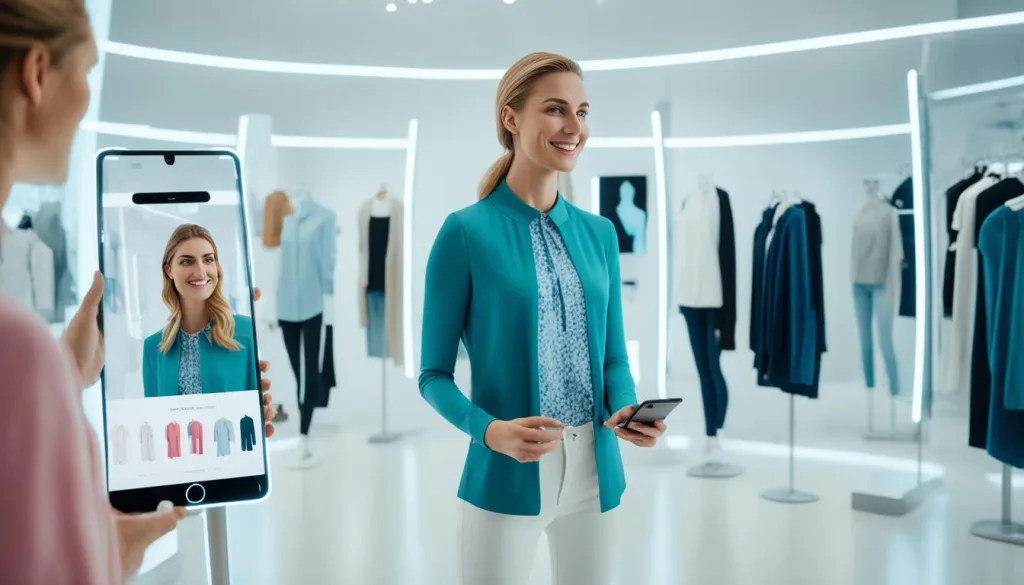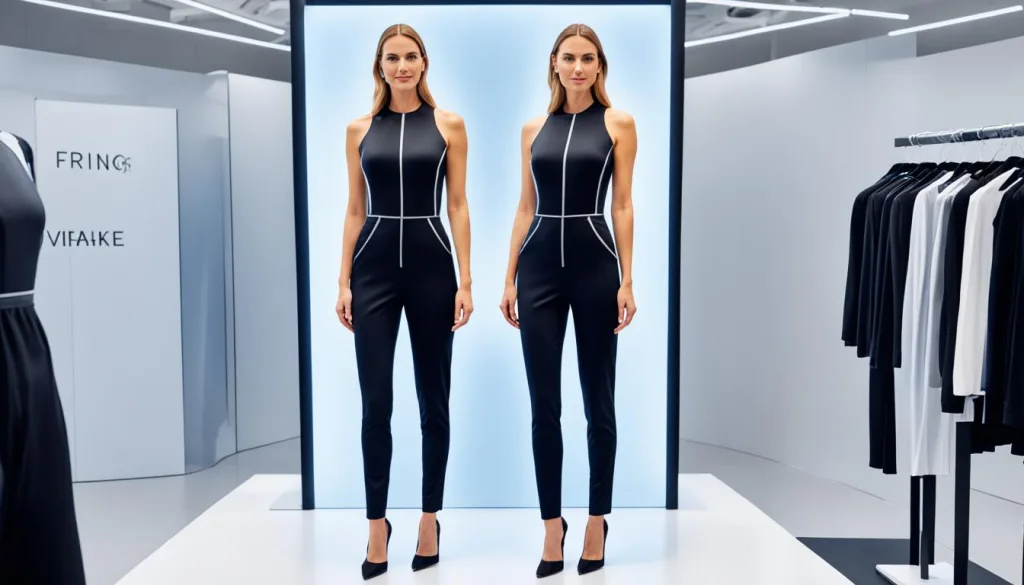Smart Mirrors in Retail: Changing the Way We Shop for Clothes
Connect With Us Today
Consider us for your next production run. Why wait? Send us your questions here.
Retail Technology is revolutionizing how we shop, with Smart Mirrors leading the change. These mirrors offer a customized fit and style, showing us the Future of Retail. Now, 85% of shoppers make their final choices in the fitting room1. Retailers are using smart mirrors to increase their sales and make shoppers happier by raising the Average Dollar Sale (ADS).
Key Takeaways
- Smart Mirrors are instrumental in modernizing the retail environment.
- Interactive mirrors transform customer experiences by providing real-time personalization and recommendations.
- Virtual technologies like AR and AI are reshaping shopping habits and boosting purchase decisions.
- E-commerce and brick-and-mortar hybrids present new opportunities for customer engagement through innovative shopping solutions.
- Leading brands adopting Smart Mirror Technology are experiencing notable increases in sales and customer satisfaction.
- Anonymous data gathering via Smart Mirrors offers valuable insights, reinforcing privacy with anonymized analytics.
- The integration of digital and physical retail experiences sets the tone for the Future of Retail.
Exploring Smart Mirror Technology in Modern Retail Spaces
Smart Mirror Technology is making big waves in retail markets. It’s changing how customers shop and boosting the value of Retail Technology. With smart mirrors, shopping has become more interactive, changing the retail game.
The Emergence of Smart Mirrors in Retail Markets
Before, only about 28 percent of shoppers used dressing rooms. Now, Smart Mirror Technology is changing that. Stores like Nordstrom and Neiman Marcus have added high-tech fitting rooms. This makes shopping more engaging and can boost sales2.
Smart mirrors are changing how clothing stores work with their customers.
Innovative Features of Smart Mirrors Tailored for Retail Use
Adidas’ smart mirrors in London let shoppers try clothes virtually and share on social media. This not only makes shopping fun but also increases the value of this technology3. H&M’s smart mirrors get customers to engage more by taking selfies. Wella Professionals has added over 50 services to their smart mirrors. This shows how customizable these devices are3.
How Increased Market Value Reflects Growing Adoption
The Smart Mirror market grew from $2.82 billion to $3.28 billion in a year. This growth shows more stores are using smart mirrors. They help reduce returns and keep stores ahead in Retail Innovation. This could open up to $21 trillion in opportunities in the metaverse4.
| Feature | Impact on Retail | Example Brands |
|---|---|---|
| Virtual Try-Ons | Increases purchase likelihood | Nordstrom, Neiman Marcus |
| Sales Volume | 2.5x faster sales with 30% more items bought2 | Various Retailers |
| Customer Engagement | 86% selfie scans, 10% email sign-ups3 | H&M |
| Market Value Growth | Projected reach of $5.58 billion3 | Industry-Wide |
Smart Mirrors in Retail: Changing the Way We Shop for Clothes
Smart mirrors are shaping the future of shopping in a big way. At Macy’s, they’re using AR mirrors for customers to virtually try on Disney Princess dresses. This makes shopping more fun and engages customers more1. Amazon and other companies are also getting into smart retail. They use QR codes on clothes so customers can easily add items to their online carts. This makes shopping smoother and helps with keeping track of inventory1.

Nike’s stores in Paris and London have smart fitting rooms. These mirrors guide customers in finding the perfect size and fit. This cool tech boosts visits to their stores1. Savage x Fenty teamed up with Fit:Match for virtual fitting rooms. They use AR and AI for precise measurements and to suggest products. This tech leads to happier customers and might increase sales1.
| Retail Innovation | Description | Impact |
|---|---|---|
| Macy’s AR fitting rooms | Virtual try-on for Disney Princess dresses | Enhanced engagement |
| Amazon QR codes for apparel | Link to online shopping cart | Seamless experience, inventory management |
| Nike’s smart fitting rooms | Guided size and fit exercises | Increase in-store experience and traffic |
| Savage x Fenty’s Fit:Match tech | AR body scans and AI for fitting | Quick measurements, personalized recommendations |
Neiman Marcus is testing MemoMi’s smart mirrors in their stores. These mirrors show outfits from all angles and let you compare looks side-by-side5. Rebecca Minkoff’s stores use RFID tech to increase purchases by 30%. These examples show how smart mirrors can change shopping and boost sales1.
Smart retail today merges innovation with insights from consumer data. Neiman Marcus’s mirrors gather data on shoppers while keeping their info private5. This approach helps retailers give a personal touch and compete with online stores. It’s about amazing the customer and understanding their needs5.
Enhancing the In-Store Experience with Virtual Fitting Rooms and Interactive Displays
Today, retail is changing fast, thanks to tech like Virtual Fitting Rooms, Interactive Retail Displays, and Smart Mirror Technology. These innovations make shopping smooth and fun. They grab customers’ attention and keep them interested.
Personalized Shopping with Virtual Assistants

Smart Mirror Technology has started a new chapter in shopping. It offers virtual help, making the experience better. This could lead to more sales and better customer loyalty1.
Customers can try clothes without changing rooms. This reduces wait times. It also helps stores know what you like, making future recommendations better1.
Boosting Sales through Targeted Advertising and Omnichannel Purchasing
Nike and Amazon are using tech to improve their stores. Nike’s mirrors show customers how clothes move with them. This brings more people to their stores. Amazon’s QR codes make online shopping easier, which saves money and helps shoppers1.
eBay and Nordstrom have tech that makes shopping faster. This tech helps customers make quicker decisions and buy more6.
Interactive Elements Transforming Retail Entertainment
Interactive Retail Displays make shopping more than just buying. At Neiman Marcus, the MemoryMirror shows how outfits look without trying them on. This leads to exciting fashion discoveries and more purchases6.
Savage x Fenty’s tech uses AR for body scans. It gives instant fit advice. This innovation boosts sales and keeps customers coming back for more1.
New retail tech blends virtual and physical shopping. It creates an enjoyable and tailored shopping future. As stores use these tools, shopping becomes a whole new experience. This benefits both customers and businesses.
Retail Innovation Examples: Success Stories of Smart Mirrors
Smart mirrors show huge leaps in Retail Innovation. Retailers use this tech to offer unique, personal shopping experiences. Technological advancements like Sephora’s Color IQ and Lip IQ help customers find perfect makeup shades. This greatly influences their shopping decisions7.
The giant in fast fashion, H&M, uses AI to examine sales and returns. This helps keep the most wanted items in stock. Likewise, American Eagle has made shopping easier with interactive dressing rooms. This has changed the fitting room experience for the better7.
Integrating smart technology in retail spaces not only elevates the consumer experience but also enacts a transformation in how retailers engage, understand, and serve their customers. — Success Stories of Smart Mirrors.
| Brand | Technology | Impact |
|---|---|---|
| Neiman Marcus | Snap. Find. Shop. App | Enhances product discoverability through photo searches7 |
| Rebecca Minkoff | Smart Mirrors | Delivers an interactive shopping journey in fitting rooms7 |
| Walmart | Shelf-Scanning Robots | Improves inventory management and restocking efficiency7 |
Not just fancy brands, but stores like Lowe’s and Kroger are using smart tech too. Lowe’s LoweBots help 80% of shoppers find products. Kroger’s smart shelving shows items to customers based on what they like7.
- North Face uses IBM Watson to help customers pick the best coat for their activities7.
- The Amazon Go store offers checkout-free shopping with AI for a quick, easy experience7.
- Starbucks’ voice-activated ordering means customers can avoid waiting in line, showing how modern tech meets customer needs7.
Retailers adopt new tech to improve operations and keep customers coming back. Success Stories of Smart Mirrorsprove their value. As retail changes, smart mirror tech is likely to play a bigger role in shopping experiences.
Conclusion
In the fast-changing world of retail, Smart Mirrors in Retail are leading the way towards innovative shopping experiences. These high-tech tools promise to boost sales by offering virtual try-ons and personal product advice based on each shopper’s body type. This helps avoid the long waits usually found in fitting rooms1. By combining personal attention with efficiency, a new shopping era is emerging. It offers a shopping journey that is both high-tech and deeply personal.
Smart fitting rooms are changing shopping for the better. They help shoppers find the perfect size and style, and build personal profiles for tailored recommendations1. This personal touch can lead to higher sales, by encouraging shoppers to buy more1. Big names like Macy’s and Nike are using this tech to create unique shopping experiences. They show just how vibrant and smooth shopping can become with the use of smart mirrors1.
The rise of Retail Technology is also seen in partnerships, like Savage x Fenty’s with Fit:Match. Here, virtual fitting rooms use AR and AI for customized suggestions, boosting sales and customer loyalty1. This shows how retail is growing smarter, meeting shoppers’ needs in thrilling new ways. As smart mirrors evolve, we’re on the brink of a retail revolution. It’s a future where shopping is both personalized and innovative.
FAQ
What are smart mirrors in retail?
How do smart mirrors enhance the shopping experience?
Which retailers have successfully implemented smart mirror technology?
What are virtual fitting rooms and interactive displays?
How do virtual assistants enhance the shopping experience with smart mirrors?
How do smart mirrors boost sales?
What are some examples of successful smart mirror implementations in the retail industry?
How do interactive elements transform retail entertainment?
How are smart mirrors shaping the future of retail?
Source Links
- https://www.forbes.com/sites/jiawertz/2023/11/22/the-high-tech-future-of-fitting-rooms/
- https://www.seattletimes.com/business/smart-mirrors-in-fitting-rooms-give-shoppers-a-different-look/
- https://www.netguru.com/blog/smart-mirrors-in-retail
- https://www.forbes.com/sites/bernardmarr/2022/07/01/the-metaverse-digital-dressing-rooms-and-the-future-of-fashion-retail/
- https://www.cbsnews.com/news/how-smart-mirrors-are-boosting-clothing-sales/
- https://www.dallasnews.com/business/retail/2015/05/11/high-tech-fitting-room-smart-mirrors-could-help-you-be-the-fairest-one-of-all/
- https://www.forbes.com/sites/blakemorgan/2019/03/04/the-20-best-examples-of-using-artificial-intelligence-for-retail-experiences/
Latest News
How Collaboration Shapes Consumer Preferences in Sportswear
Navigating Consumer Rights and Warranties in Sportswear Sales
Artificial Intelligence in Fashion Forecasting and Trend Analysis
The Shift Towards Inclusive Sizing in Sportswear: Consumer Reactions
The Global Expansion of Luxury Sportswear Brands
From Sketch to Gym: The Design Process of Fashionable Sportswear
Understanding the Role of Trade Associations in Sportswear Compliance
How Economic Trends Influence Consumer Spending on Sportswear
Learning from Successful Global Market Entries
Best Practices for Managing Cross-Cultural Teams
Using Technology to Fight Counterfeit Fashion Products
Carbon Nanotube Fabrics for Superior Strength and Flexibility
The Growth of Fitness Tracking Apparel in Health and Wellness
Exploring the Influence of Social Proof in Sportswear Purchasing
Strategies for Managing Compliance in a Multinational Operation
Trends in Global Footwear: Performance Meets Lifestyle
The Role of Artificial Intelligence in Tracking Supply Chain Operations
Evaluating the Success of Sportswear Collaborative Projects
Evaluating the Potential of Emerging Markets
Global Shifts Towards Gender-Neutral Sportswear
Share This Article
Latest Articles



















